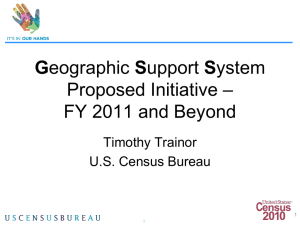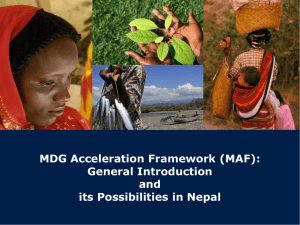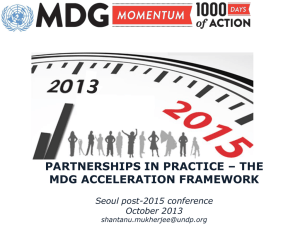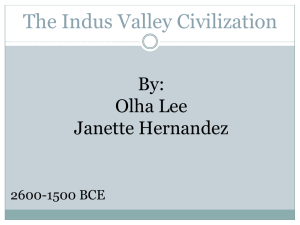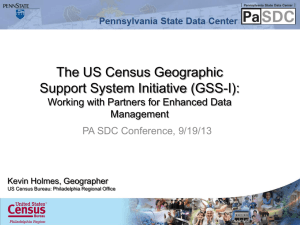6. Water for Nature in the Downstream Areas
advertisement
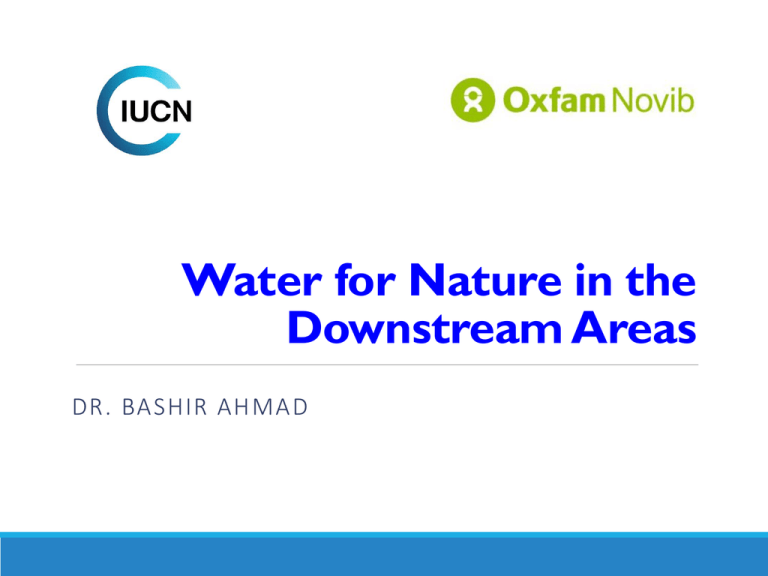
Water for Nature in the Downstream Areas DR. BASHIR AHMAD Environmental Flows Environmental Flows refer to water provided within a river or wetland to maintain ecosystem services and benefits they provide. Environmental Flows describes the quantity, quality and timing of water flows required to sustain ecosystems and the human livelihoods and well-being that depend on these ecosystems 2 Environmental Flows Environmental flows are effectively a balance between water resources development and the need to protect freshwater-dependent ecosystems. Other definitions and terms regarding environmental flows do exist. These include minimum, in stream and ecological flow. 3 Environmental Flows- Indus System In average year 74% of the Indus River flows are abstracted for irrigation and it reaches to 88% in the dry years and reduces to 50% in the wet years. As a result of upstream water abstractions, mainly for irrigation, by the time the Indus reaches the Kotri barrage, there is inadequate flow to maintain the natural ecosystems of the Indus delta in the dry years and too much water in the wet years. Freshwater Below Kotri reaching the delta was argued by the lower riparian to be insufficient to maintain healthy natural ecosystems, and had resulted in saltwater intrusion and salinization. 4 Environmental Flows- Indus System The lower riparian views this situation in the context of preKotri and pre-Tarbela periods, which is now a history, as Tarbela dam was constructed 38 years ago. Now the flows below Kotri in the post-Tarbela context need to be assessed. The serious concern is in those years when the flows below Kotri are less than 3.6 MAF as proposed by International Panel of Experts (IPOE) 5 Indus Delta Ecosystem Built up by the discharge of large quantities of silt washed down from upland and mountain areas Stretched over an area of about 41,440 km². The active part of the delta is 6,000 km² in area. It is characterized by 17 major creeks and innumerable minor creeks, mud flats and fringing mangroves Mangroves resource – 6th largest in the world Home to many birds, fish and Indus Dolphin 6 Mangroves of Indus Delta There has been a significant reduction in the area of mangroves in the Indus Delta over the last 30 years Mangrove coverage 0.4 mha in 1965 0.263mha in 1977 0.158 mha in 2001 Mangroves Pockets Miani Hor: 7,471 ha Kalmat Khor: 10,216 ha Gawatar Bay: 26,316 ha Environmental Issues Sea water intrusion Soil salinity and sodicity Environmental pollution Loss of mangrove forest Reduced supply of fresh waters Untreated wastewater discharge Land clearance Factors Responsible for Degradation of Indus Delta Decline in Below-Kotri Fresh River Flows • Pre Tarbela: 58.5 MAF (50% probability) • Post Tarbela: 26.9 MAF (50% probability) Indiscriminate Mangroves Cutting • Factor are fuel wood, timber mafia, encroachment, land mafia, urbanization, over gazing, effluents and meandering creeks 9 Factors Responsible for Degradation of Indus Delta Enhanced Catch of Fish using Smaller Nets Toxic Industrial Effluent Disposal Urban Pollutants Disposal 450 to 472 million gallons per day of sewage is generated in Karachi Karachi Water and Sewerage Board are treating about 30% of wastewater and sewage; rest goes into sea without any treatment BOD and COD is a Major Concern at Coast wide range of pollutants at Orangi Nala and Lyari River waters known Orangi Pilot Project also disposing all the sewage in to the streams leading to the coast 10 Below Kotri River Flows Pre Tarbela: 58.5 MAF (50% probability) Post Tarbela: 26.9 MAF (50% probability) Affected by extreme variability of Indus river flows, highest 91.8 MAF, lowest 0.3 MAF and average of 26.9 MAF (1976-13) Downstream flows are highly erratic as most of the flows are released during water surplus monsoon period of three months from July to September 8 out of 38 years when flows were > 50 MAF 9 out of 38 years when flow was < 10 MAF 21 out of 38 years when flow was < 1MAF (in rabi season) 11 Below Kotri River Flows frequency of zero flow days in the Rabi season has a direct impact on the downstream system Zero flow days occurred in 28 years (73%) in kharif and 38 years (100%) in the Rabi Highest zero flow day 180 in Rabi Zero flow days reached 300 in 2 years (2000-01 & 02) River below Kotri remained dry for 200 or more days 5 out of 20 (25%) years in pre-Terbela and 9 out of 38 (24%) years in post-Terbela periods 12 Variability in Below Kotri River Flows Flow Downstream Kotri Barrage P(MAF) Pre-Terbela (1956-1975) Post-Terbela (1976-2013) Rabi Kharif Annual Rabi Kharif Annual Percent Change (+/-) Maximum 0.0 8.1 8.1 0.0 0.2 0.3 -96.3 90 0.0 21.0 21.2 0.0 2.1 2.1 -90.1 75 0.4 30.3 35.9 0.1 10.9 11.0 -69.4 50 2.9 57.0 58.5 0.7 26.7 26.9 -54.0 25 8.4 73.1 91.1 2.6 43.8 45.4 -50.2 10 18.1 10.7.0 121.0 5.0 64.1 69.1 -42.9 Minimum 20.7 108.1 128.8 12.3 88.2 91.8 -28.7 Probability of Excedence (%) Extreme variability between highest and lowest flows Highest flows reduced & lowest further lowered in post Terbela 13 Drivers of Low Flows Below Kotri Flows abstractions of Eastern Rivers by India Periods Kharif Rabi Annual Change (%) Pre-IWT (1937-60) 19.80 4.13 23.94 Pre-Terbela (1961-75) 13.42 2.17 15.59 -35% Post-Terbela (1976-2013) 5.19 1.43 6.70 -57% Irrigation network development Period Pre-Independence 1937-47 Kharif 44.39 Rabi 18.49 Annual 62.89 Change (%) Pre-Treaty 1947-60 Pre-Mangla 1960-67 Pre-Tarbela 1967-76 Post Tarbela 1976-2013 Increase from 1937 to 2013 48.58 57.11 61.68 63.89 23.24 25.85 28.20 32.97 71.82 82.97 89.88 96.87 +8.93 (14%) +11.15 (16%) +6.91 (8%) +6.99 (8%) +33.98 (54%) 14 Drivers of Low Flows Below Kotri Declining trend of western river flows: Western rivers flows decreased from 139.7 MAF during (19371976) to 128.2 MAF during (1976-2013) period (8.23 % decrease). Domestic and industrial demands • 2.5 MAF/year in the early 1975s (FAO STAT) • 12.38 MAF/year in 2007-08 (400 % increase) • 17 MAF/year by 2025 due to rampant population growth, industrialization and urbanization Extreme events • Pakistan experienced extreme events recently floods in 2010, 2011 and 2012 and severe drought of 1999-2003 which had severe impacts on Indus delta. • Predictions are that these sorts of extreme events are likely to be repeated more frequently and cause even more severe problems. • By the end of the century, temperature in the deltaic region could increase by 40C 15 Minimum Environmental Flows Water Apportionment Accord established water entitlements, expected future storage (10 MAF) and need for flow below kotri. Different opinions on minimum escapage below kotri (10 MAF as interim outflow). Three studies were agreed and commissioned to reach consensus on the minimum required escapages below Kotri barrage: i. ii. iii. Determine minimum flow below Kotri barrage to control seawater intrusion into the delta Environmental impacts from river water and sediment flows and their seasonal distribution below Kotri barrage Environmental concerns about a wide range of issues related to the management of water resources upstream of Kotri barrage These reports were then assessed by an International Panel of Experts (IPOE) 16 Minimum Environmental Flows IPOE Recommendation An escapage at Kotri barrage of 5,000 cubic feet per second throughout the year (3.6 MAF) to check seawater intrusion, accommodate the needs for fisheries and environmental sustainability, and to maintain the river channel. It is recommended that a total volume of 25 MAF in any five-year period be released in a concentrated way as flood flow (Kharif period) to maintain sediment supply to the mangroves and coastal zone”. 17 Minimum Environmental Flows The accord did not specify how these environmental flows would be accommodated within the allocations Would they come “off the top” thus reducing allocations to all provinces) or come out of the allocations to Sindh the province in which the delta is located? IRSA has been including environmental flows from “off the top” while calculating the allocations for the provinces. The accord also did not assign responsibility for delivering and monitoring these flows. 18 Minimum Environmental Flows The recommendations of the Panel study, however, could not be materialized, so far due to unknown reasons. Increasing zero flow days indicate that Panel recommendation of 5000 cfs per day is not being exercised In the absence of implementation of the Panel’s recommendation which is based on detailed studies and analysis of reputed international experts as per decision of the Accord, controversy of minimum environmental flows persists. 19 Way Forward • International Panel of Experts recommendation must be enforced in true letter and sprit • Some viable, transparent system for flow measurement must be enforced • Study to assess the damage already done to mangroves, fisheries, livestock and other manifestations of bio-diversity in the Indus delta • Ensure effective enforcement of National Environmental Quality Standards for municipal and industrial effluents 20 Way Forward • Develop a reliable system of data collection, storage and sharing • Also initiate studies for ecosystem characterization and their valuation 21 THANKS 22





